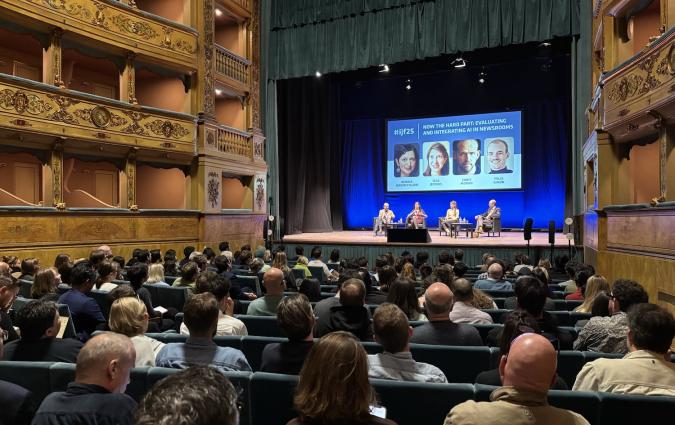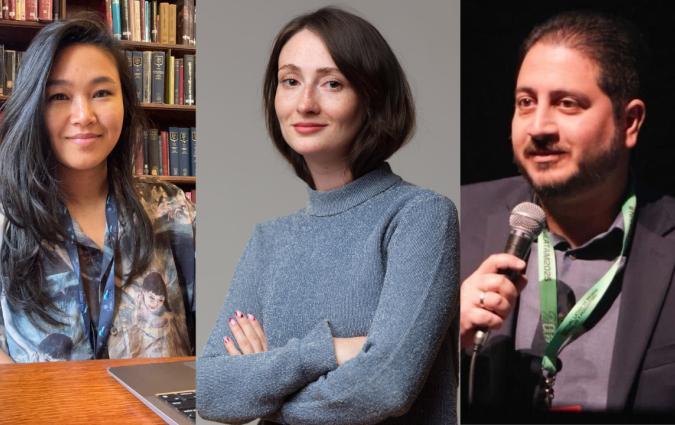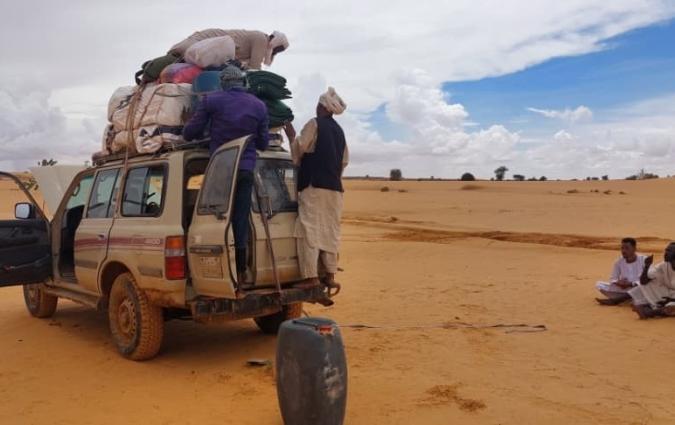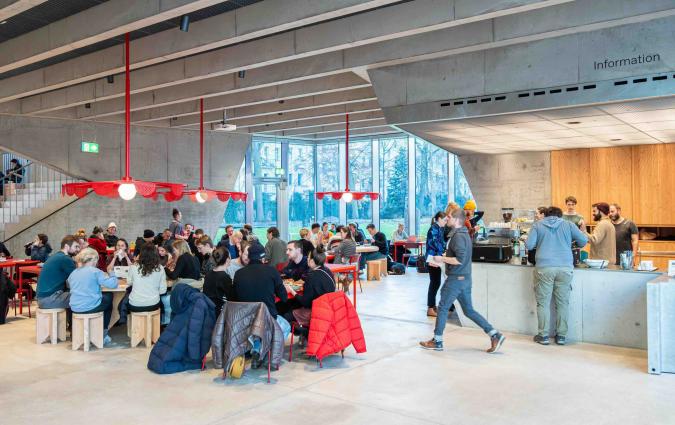Defiance under fire: three voices from Ukrainian journalism on how Russia's invasion changed their work and their lives
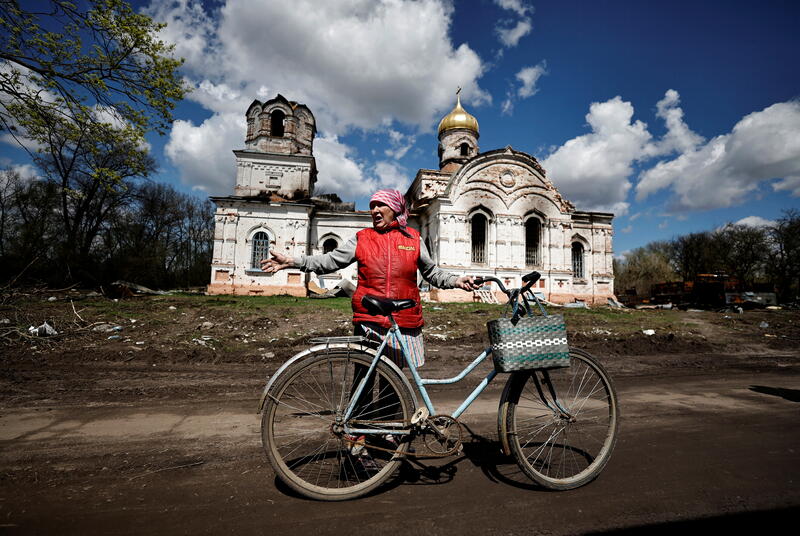
Nadia Denysevych, 62, talks to journalists in front of the destroyed church that according to residents was used by the Russian Army as a munitions warehouse in Lukashivka, Chernihiv region, Ukraine April 27, 2022. REUTERS/Zohra Bensemra
On 24 February 2022, Ukrainians woke up to the news of a full-scale invasion and to missile strikes on many of their cities. Life changed overnight for all Ukrainians. Many left for other European countries. Others stayed to help their fellow citizens despite the risks. Journalists face similar dilemmas. Some joined the army to defend their homeland. Others kept working for their news outlets or became war correspondents in their own towns.
One year after Russia’s all-out aggression, I wanted to hear from different sections of Ukrainian news media to learn how the war has changed what they do. I spoke to a field producer working on the frontline, a famous TV presenter, and the CEO of a popular newspaper. Their experiences give a broad perspective on how the war changed Ukrainian media and the people working in it.
The field producer
When Russia launched its full-scale invasion, Alex Babenko had just earned his master’s degree in journalism. He had recently started to work in cinematography, making films, TV series and music videos in Kyiv.
“I knew I would be a war journalist,” he says. “It's the best I could do. It's the thing I have expertise in. So, from late February I've been working with foreign media to cover the war in Ukraine.”
Babenko is 24, and many of his formative experiences took place against the backdrop of growing Russian aggression towards Ukraine. Most influential on young Ukrainians was the 2014 Revolution of Dignity, when, following protests in favour of closer relations with the EU, clashes with riot police led to 108 protester deaths and the ousting of the pro-Russian president Viktor Yanukovych. After these events, Russia annexed Crimea and supported separatists who began fighting state forces in the Eastern Donbas region.
“This had a strong influence on me because I was a teenager,” Babenko says. “I was in high school. That’s when I decided to study journalism. It changed me.”
On the day I speak to him, Babenko has been to Bakhmut, an Eastern Ukrainian city that has been the focus of fierce fighting in the last couple of months. “Today, we were 800 metres from the Russian positions,” he says. “I rarely come closer than this. It's very close. A sniper could see you from this distance.”
However, safety is always a priority in his line of work. Babenko has completed several training sessions. In these situations, he always wears personal protective equipment and carries tourniquets for potential injuries. “It's an artillery war and it's hard to protect yourself because you could be a target everywhere,” he says. Nevertheless, he follows the rules: “We never go to cover street fighting, because it's too dangerous.”
Babenko works with people who have been through several wars. “I worked with Paula Bronstein and with Phillip Robertson, who was in Iraq, Afghanistan and Syria,” he says. “These are very experienced people who could help me understand the war. I’ve travelled a lot and I know Ukraine well. But I don't know war well, and in this kind of work, you must absolutely trust your team. I'm not too careful. I like frontline stuff and I love being here, but I don't want to die.”
Babenko is currently working as a video contributor and field producer for Getty Images, and his Instagram feed is filled with photos from war-torn regions: children standing outside ruined buildings, funerals of soldiers, and rubble covered in snow.
Instagram has placed a sensitive content warning on one of its posts.
“I hadn’t seen bodies before, and first it was kind of a shocking experience,” he says. “Even now I think I could close my eyes and remember each dead body that I photographed. But I can't say that it comes to me in nightmares. It's just a part of reality, and it wouldn't be good not to cover it, because this is war, war is death and we need to show it.”
The TV presenter
Andrii Dikhtiarenko is the editor-in-chief of the news division at Ukrainian public broadcaster Suspilne. He comes from Luhansk Oblast, one of the regions occupied by Russian-backed separatists in 2014, but was based in Kyiv when the war began.
“[When the full-scale invasion started] we were prepared because we became an internally displaced organisation nine years ago, but the high-scale conflict gave us a lot of new problems,” Dikhtiarenko says. “First of all, we needed to save our own lives.”
Several of Dikhtiarenko’s team members had to move their work and their families out of the Eastern Ukrainian regions that would become the main targets of Russian aggression, fleeing westwards from war for a second time.
Even in the chaos of those first few days, Dikhtiarenko and his team kept up their journalistic work. “My deputy editor produced a journalistic investigation about Russian pilots who bombed Ukrainian cities,” he says. “He was moving from Kharkiv to Vinnytsia and this journey took many days because the roads in Ukraine were overcrowded with refugees.”
On the first day of the full-scale invasion, a joint information telethon began, with public and private TV channels coming together to broadcast the same programme focused on war-related issues, with teams from the channels working in rotating six-hour slots. Almost a year on, the telethon, known as United News (Єдині новини), continues airing 24 hours a day, seven days a week. Suspilne’s Pershyi is one of the participating channels, and Dikhtiarenko is one of its presenters.
“It's really helped people, especially in the first months of this war, not to be disoriented and to understand what’s happening,” he says. “You must find the right words to explain everything you need to explain. But you must also support people emotionally as they have to interact with horrific news. Sometimes when we’re on the air, we have bombings and shelling, and we must quickly go to a shelter where we have studios and from where we continue to broadcast. We often deal with blood and suffering. A lot of people around us right now are fighting against Russia. There are also a lot of deaths.”
Dikhtiarenko explains that the first month was the most stressful one. “It was difficult to focus on your own emotions, your own frustration or fears because you were a small part of a big suffering country,” he says. “A lot of people were dying. At that moment I tried to understand what I could do, and how best I could help my country. I was an editor with almost 20 years of experience, and I was from an occupied territory. I knew a lot of what people felt when their houses came under shelling and they needed to escape. My experience was really needed. This experience helped me.”
Dikhtiarenko joins our scheduled call a few minutes late and apologises: he has lost connection because of a blackout. “Today we had three rocket shellings from Russia. Most of these were shot by our air defence system and everything is fine. But 30 minutes ago, the light was off. Every journalist has big power banks and car batteries in their house, which we use to try to stay connected to the internet and continue our work,” he says.
I say I am sorry, but he brushes it off. “It's not the most traumatic thing that we have right now,” he says.
The CEO
Andrey Boborykin is the CEO of Ukrainska Pravda, one of the largest and oldest digital-first news organisations in Ukraine. He's been on the job for a year and a half, with most of his tenure overshadowed by war.
Boborykin says Ukrainska Pravda has fared better than most news outlets in Ukraine in the past year. The war brought them an unprecedented traffic spike. Throughout the first few months, its website got close to 1 billion page views, Boborykin says. One year on, it’s recording almost twice as many monthly unique readers and sessions and more than twice as many monthly page views than in January 2022.
As the invasion started, Ukrainska Pravda managed to gain more funding from donors and increased the newspaper’s revenue in an unexpected way. “Part of our active audience moved abroad,” Boborykin says. “After some time, they came to be considered as people living in those markets by programmatic advertising networks. This allows us to make significantly more money off advertising. The Ukrainian programmatic advertising market is 60% below pre-invasion figures. In the first few months after the invasion, it was 90% below. But in the rest of the world, it’s working as it was, and 1,000 ad impressions in the US are 100 times more expensive than 1,000 ad impressions in Ukraine.”
This is not the first crisis Ukrainska Pravda is going through. Its founder, Georgiy Gongadze, was murdered in 2000 several months after launching the newspaper. One of its most important journalists, Pavel Shemeret, was also murdered in 2016. “We’ve been through a lot of crises, and that also affects the level of response from the team,” Boborykin says. “As we are operationally and economically more sustainable, people also feel more secure.”
Even considering these circumstances, though, “the mental toll of this war is very hard on people working in news,” says Boborykin, who explains they offer counselling to their staff.
Safety has been Ukrainska Pravda’s top concern throughout the war. A small number of team members, less than 5% of overall staff, work from abroad. “It’s a way to be 100% sure that we have a backup team that will be able to publish on the website no matter what,” Boborykin says. He explains they are also renting a house close to the Romanian border, a relatively safe location for their journalists to work from if needed.
As they fear a new Russian invasion, Boborykin has a backup plan for his team to move there quickly. They’ve discussed all kinds of scenarios. “We’ve discussed what we could do if Ukraine was cut off from the internet,” he says. “We’ve also discussed totally messed up scenarios like a nuclear strike on Kyiv or Russians blowing up a nuclear power plant in Zaporizhzhia.”
The impact of the war on the business of news has been much worse for smaller outlets that couldn’t count on Ukrainska Pravda’s audience size and notoriety. Boborykin also works as an analyst for the Media Development Foundation (MDF), a media expertise hub. The MDF has worked to support Ukrainian media by opening a coordination centre for crowdfunding.
The worst off are outlets operating in heavily affected areas, those close to the frontline or occupied by the Russian army, where both audiences and journalists have been forced to leave. “For many of these organisations it’s an existential question,” Boborykin says, “Do you continue covering the territory? Obviously, you have to. But how do you do that when most of your team works remotely and when most of the people who read you are not there anymore?”
For smaller national publishers, donor funding seems to be the only life-saver as they don't have the scale to make money off programmatic advertising, Boborykin says. Some newspapers were beginning to implement reader revenue models just before the invasion, so they aren’t a substantial revenue stream for them yet.
“I wouldn't say that the local news market in Ukraine before the invasion was vibrant,” Boborykin says. “We had a lot of areas that could have been considered news deserts before the invasion. Now, this situation is 100 times worse.”
Underfunding and understaffing are also serious issues. According to an MDF report on the state of local journalism in Ukraine published in May 2022 and based on a survey of 39 local news organisations, 69% of respondents noted a lack of funds to continue the normal functioning of newsrooms and 29% of respondents said that each member of the team performs the duties of several specialists at the same time.
Something Boborykin is now working on with MDF is a plan to launch small newsrooms on formerly occupied territories when the war ends, as well as on the news deserts that already existed and expanded during the conflict. “The people will go back and we need to establish proper coverage for the communities there,” he says.
In every email we send you'll find original reporting, evidence-based insights, online seminars and readings curated from 100s of sources - all in 5 minutes.
- Twice a week
- More than 20,000 people receive it
- Unsubscribe any time


